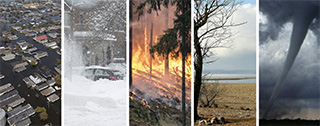
The Visible Signs of Climate Change

Blog Co-Author: Samantha Fox, Senior Consultant, IBM Global Business Services
The effects of climate change are already observable around the world, and a compelling number of scientists agree that the effects will continue to worsen over the next century. Among these predicted effects of climate change are rising temperatures and sea levels, changes to the life cycle of many plants and animals, and increasingly severe weather events.
Natural disasters are on the rise and so are the costs associated with them. The year 2017 holds the record for the costliest billion-dollar disaster event coming in at over $300 billion dollars, and is tied with 2011 for the highest record of billion-dollar disaster events (16 Events). Since 1975, scientists at the National Center for Atmospheric Research have concluded that due to climate change “there has been a substantial and observable regional and global increase in the proportion of Cat 4–5 hurricanes of 25–30% per °C of anthropogenic (human-caused) global warming,” and another study published by the American Meteorological Society predicts an overall “global increase in storm frequency of 9% and a 23% increase in the Atlantic basin by the end of the 21st century.”
The most visible effect of climate change is the melting of Polar ice and glaciers, causing sea levels to rise. In July 2019 alone, Greenland lost over 197 billion tons of water due to an ice sheet melting according to researchers at the Danish Meteorological Institute. While places in the Artic are getting hotter, so too are human habitats that already experience extreme heat temperatures. July 2019 was the hottest month on record, the deadly heat was felt throughout the United States, Europe, and India, and temperatures are predicted to increase over the next 60 years. And temperature isn’t the only facet of weather affected by climate change. While reporting about a study done at the Potsdam Institute for Climate Impact Research, an article in the New York Times asserts that “extreme rainfall, and the extreme lack of it, affects untold numbers of people, taxing economies, disrupting food production, creating unrest and prompting migrations.”
With the change to weather patterns, many metropolitan cities will significantly be affected. The United Nations estimates that the majority of the world’s population will live in cities by the year 2050. This quickly turns the problem of coastal and river flooding into a crisis that municipal cities, states and federal governments must deal with in the immediate future. C40 Cities predicts that “over 800 million people, living in 570 cities, will be vulnerable to sea level rise and coastal flooding.” While the U.S. EPA notes that cities will have to cope with future flooding and sea level rise, in some places citizens will be forced to relocate out of flood prone areas to safer and higher grounds. The World Bank predicts that over 140 million people will become climate change refugees by the year 2050.
Corporations and supply chains will also suffer the impacts of climate change. According to the 2017 United Nations Conference on Trade and Development, “maritime transport is a most important global industry that facilitates the movement of goods and people… as about 80 % of goods have at least one maritime transport.” While impacts of climate change like a rise in sea levels or change in agricultural products would have a clear impact on ports and other methods of goods transportation, a World Bank study found that changes in weather patterns and socio-economic implications from lack of trade would create a profound bearing on supply chains, businesses, and consumers.
While global populations continue to shift into cities, climate change is beginning to impact all facets of human life. Natural disasters are occurring more frequently. Building urban resiliency from weather related events is becoming the new normal. These problems will grow in complexity and require extensive analytics and a public private partnerships to address. Sound management of technology can foster capabilities to address the causes and prepare for the impacts of climate change. The next blog in this series will focus on methods of preparation for climate change’s effects.
Image Courtesy of Pixabay.com



